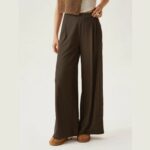Let’s face it, some of us drew the short end of the stick when it comes to height. As a shorter guy myself, I get it – the feeling that people don’t take you as seriously or the assumptions made about your confidence level.
While we know that height doesn’t define a person, it can be hard not to wish for just a few more inches from time to time.
What are Elevator Shoes?
That’s where elevator shoes come in! Elevator shoes, also known as height-increasing shoes, are specially designed to boost your height.
They use discreet lifts in the shoe’s midsole that can add 1-5 inches to your overall height. I know what you may be thinking – elevator shoes sound like some gimmick that only exists in movies.
But let me tell you, the elevator shoe industry has come a long way from the obvious and awkward styles of the past.
These days you can find elevator shoes and boots in all styles, from casual sneakers to formal Oxfords, that look and feel just like a regular pair of shoes.
I want to walk you through all the important factors to consider when shopping for the best elevator shoes.
Like buying a regular pair of shoes, fit and quality should be your top priorities so you end up with something comfortable that will last.
How to Find the Right Elevator Shoes
The key to both comfort and disguise is finding elevator shoes engineered specifically for your foot size. Brands like Chamaripa offer shoes in every men’s size so you can get a custom fit.
An elevator shoe stretches your foot vertically so the base and sides can’t be too narrow or tight. An ideal elevator shoe should use a last that is elongated but not bunched together, avoiding a squished effect.
How Do Elevator Shoes Work?
Elevator shoes may have a slightly different construction than regular shoes to accommodate the lift. Look for shoes made from quality leathers with attention to detail like fiddle back waist, blind welts, and durable midsole tech.
The height increasing part of the shoe is either a foam, plastic or EVA lift discretely built into the midsole. Avoid cheap shoes with plastic soles that feel stiff and uncomfortable.
Elevator Shoes Also Come In Various Styles
While elevator shoes used to be equally boring and clunky, today there are elevated options for every occasion. You can find elevator boots, dress shoes, casual sneakers, and everything in between.
Look for styles from top-notch brands that offer both classic and modern models. Rather than stick out, a good elevator shoe should blend right in with your wardrobe.
How to Walk in Elevator Shoes
If you’re new to wearing elevator shoes, I recommend starting with a more subtle 1-2 inch increase and gradually working your way up.
This allows time to get used to walking, balancing, and moving in your new shoes.
Start with casual, everyday styles (like height increasing sneakers) you can break in before progressing to dress shoes or boots.
Comfort & Quality Are Key
Avoid cheap brands and poor construction that prioritize height over comfort and durability. Trust me, uncomfortable shoes that fall apart after a few wears are no bargain.
Seek out established companies focused on high-quality materials and craftsmanship. Your shoes should feel like a natural extension of you, not a nuisance.
Now you’re ready to start browsing styles and get excited about that extra boost of height on the way. While elevator shoes remain one of the less-known fashion topics, they have been sought out by celebrities like Vin Diesel, Tom Cruise, and Sylvester Stallone for years.
Shorter men around the world wear them with confidence in cities like London and NYC. Next time you’re looking to command respect on big days like job interviews, weddings, and more, slip on a pair of attractive, discreet elevator shoes.
You’ll be looking at mantles, bouncers, and the world eye-to-eye.
FAQ
Which shoes give the most height?
Elevator shoes can give you extra height, often ranging from 2 to 5 inches. These shoes have built-in hidden lifts in the heels. The actual height you can gain depends on the model and design.
For example, Chamaripa elevator boots can make you taller because of their special design and hidden height increasing insole technology.
Can you wear elevator shoes every day?
Yes, you can wear elevator shoes every day. However, as with any footwear, ensure they fit properly and are comfortable. Too tight can injure your feet over time. Thus, give your feet a break.
Do you need longer pants with elevator shoes?
This question depends on how much height the elevator shoes add and the original length of your pants. If the shoes add a significant amount of height, your pants might appear shorter when standing up.
Therefore, consider getting slightly longer pants, keeping the same look and style.
What are the disadvantages of height insoles?
Height insoles, also known as shoe lifts, are things that you can put inside shoes to make you look taller. However, they have some disadvantages:
- Comfort: Height insoles can make your shoes less comfortable, especially when worn for extended periods. That is because they reduce the space, causing your feet to feel cramped or bunched together.
- Fit: Not all shoes can accommodate height insoles. Insoles might not fit properly or could make your shoes too tight.
- Quality: Not all height insoles have the same quality. Some use cheap materials that can degrade quickly or offer little support, leading to foot pain or discomfort.
How long does it take to get used to elevator shoes?
That varies from person to person. Some people might feel comfortable in them almost immediately, while others might need a few days or weeks.
Like any new pair of shoes, there’s often a ‘breaking in’ period. Remember, comfort should always come first – if you feel any discomfort or pain, give your feet a break.








